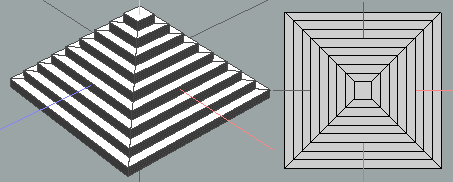| Assorted odds and ends |
 |
| Inset - Producing equal distance steps/increments |
 |
| If you are intending to extrude geometry out from these 'Inset rings', the workflow used here was - do all (Tab) Inset ops first, using Shft d, then Extrude Region Y (starting with largest ring, Tab input) and use Shft d and minus key Figures used were: 11.1111 % (1/9) 12.5 % (1/8) 14.2857 % (1/7) 16.6667 % (1/6) - then as before with 5 step example. |
| 1). Non square face + specially created cylinder with required no. of edges. 2). Match up verts on face by cutting 2 (in this case) 3). Select the 2 faces that will (eventually) touch and use Store | Selection 4). With cylinder (source) underside face selected, invoke Face | Put On (LMB) 5). Select destination face (LMB) apply Put On (RMB) then Recall | Selection 6). Apply Face | Bridge 7). Select edgeloop at join between the 2 items. 8). Loopcut (and then delete……) 9). Original face with 'circular' land - rotate as / if necessary (First part of stage 5 (Put On) could be RMB - select and execute op in one go) Can be used with non -flat faces - use flatten as and when / if necessary - obviously don't bother removing cylinder if you are going to extrude anyway? Provided the vert counts (prior to bridge op) match up, then shapes other than those shown could be used. |
 |
| Insetting / imprinting a circular face onto a quad face. |
| The actual true 'distance' moved by the Inset command isn't known unless: a) The user measures the face, decides on a 'linear' movement (for Inset increment), works this out as an appropriate percentage and (tab) enters the relevant (percentage) figure during the op. b) Inset is used and measurements take place afterwards with a sequence of 'trial and error' to obtain the (approximate) required distance. In certain situations, where a sequence of Inset ops is being carried out, special care should be taken to achieve a series of (dimensionally equal) steps. For the images above, it's been assumed that a series of steps, each of a width equivalent to 20% of the original dimension was to be achieved. Images (with larger central 'core') were produced by an intial 20% Inset operation, followed by using Shft d to repeat the op. for the appropriate number of times. Note the decreasing 'width' of each step. The second set of images were produced using a (simple) maths-based approach - this produces the correct result - dimensionally equal steps. To achieve this latter result the Inset steps used were: 20%, 25%, 33.33%, 50% or, put another way 1/5, ¼, 1/3, ½. As a general rule, decide how many (equal) steps you want, say 13 Steps required will then be 1/13, 1/12, 1/11 ………1/3, ½. Work these fractions out as percentages, the more accurate the better, as errors will be cumulative and then enter these percentage figures (using tab input) when using the Inset command. |
| Filling in cavities with Dissolve and Connect. (A situation often encountered when extrude has been used instead of extrude region) 1). Select faces surrounding 'cavity' to be 'filled in' 2). Apply Face | Dissolve (forms a single 'face' with 10 edges / verts - this could be any shape - including 'opened out' and flat, like end face of a 10 sided cylinder) 3). Situation after deselecting 4). Select pairs of verts to be connected (exact nature of geometry will determine how many pairs you can connect in one go - the rear pair were connected separately) 5). After connect, select new edges - select one, press G (Select | Edge Ring) and apply Edge | Collapse 6). Finished item An even quicker workflow for the first bit: Select faces (as in (1)) -> Face | Dissolve (Backspace) -> V (vert mode) -> C (connect) Then use Edge | Collapse (if required) as before. |
 |
| Filling in cavities with Dissolve and Connect. |
| Another possibility - if you want a middle edge (and associated geometry) to 'play around with' 1). The 2 faces to be 'filled' 2). Apply Face | Extrude Region -> Normal. Drag to required extent, so that middle edge (bottom of 'V' here) is where you want it to be. 3). Extruding to such an extent that the 'middle edge' is as shown here - even though things seem to be getting messed up - is also ok - nothing to worry about :) 4). Select the 2 edges shown here, apply Edge | Dissolve, select the whole object and apply Object | Cleanup. 5). Finished shape after cleanup. The same technique (dissolve edges, cleanup etc) will work just as well with the shape shown in 2. (It should also be noted that selecting the 2 middle edges + top edge of the 'spike' (as shown here - select side edge, press L), dissolving these and using cleanup will re-instate a standard fill situation (as with previous example) |
 |
| Using Extrude Region to 'fill' a cavity. |